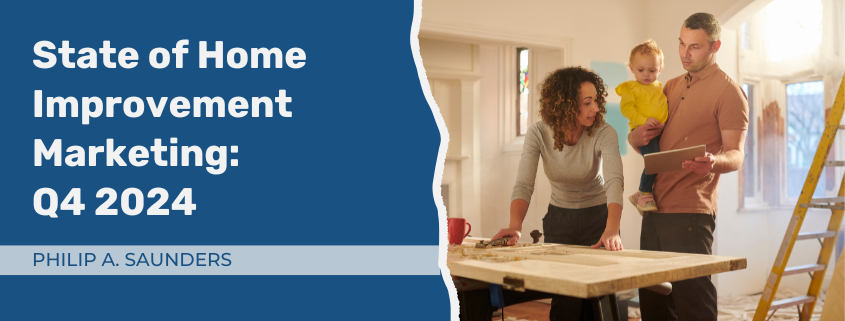State of Marketing Q4 2024: Key Takeaways from Leading Home Improvement Lead Generation Marketers
As we head into Q4 2024, the home improvement industry continues to evolve, influenced by a combination of economic shifts, consumer behavior changes, and technological advancements. For businesses in this sector, understanding the most effective marketing strategies and lead generation tactics is crucial.
Recently the team over at ProRemodeler interviewed 5 leading marketing directors of companies situated throughout the US to talk about the current state of marketing for home improvement companies. Below are some of the main takeaways:
Which Marketing Sources are Currently Working the Best for Home Improvement Companies?
The general consensus among the interviewed marketing directors was that digital marketing continues to dominate due to its scalability and measurable results. Specifically, search engine optimization (SEO) and pay-per-click (PPC) advertising are leading the pack in effective lead generation.
SEO remains a cornerstone, as high rankings in search results directly correlate with increased visibility and lead capture. PPC campaigns, particularly on platforms like Google Ads and Bing, offer the advantage of immediacy and precision targeting, crucial for companies looking to attract specific demographics.
Social media platforms, especially Facebook and Instagram, have also proven effective for visual-driven marketing, which is ideal for showcasing home improvement projects. These platforms not only enhance customer engagement but also serve as excellent tools for reputation management and brand awareness.
How Do Current Lead Costs Compare to Historical Costs?
Cost per lead has seen a noticeable increase in 2024 over last year. Several factors have contributed to this trend, including increased competition in digital spaces and rising ad costs across most platforms.
Average cost per lead can vary significantly based on specific vertical and geographic location, but there’s a general upward trend in costs across all channels. Ryan Shutt from Southwest Exteriors says his cost-per-lead across all channels is close to $600 (up from $400-$450 last year). Tim Brown Jr. from RGS Exteriors & Construction is currently averaging $596 per lead up from $290 last year.
Despite the higher costs, return on investment (ROI) seems to remain strong for those who execute their marketing strategies effectively.
How Much are Home Improvement Companies Currently Allocating for Marketing?
Home improvement companies looking to grow market share are being forced to increase their marketing spend to thrive in an ultra-competitive marketplace. Traditionally we’ve seen marketing budgets in this space average between 8% and 12% of revenue. More recently we’re seeing a marketing spend range of 10-15% for the home improvement sector.
This increase reflects the need to invest more in competitive and high-cost marketing channels to maintain visibility and lead flow. It’s also indicative of the greater emphasis on comprehensive digital marketing strategies that encompass a mix of SEO, PPC, social media, and content marketing.
Home Improvement Sales Trends: Are They Generally Up or Down in 2024?
Overall sales trends within the home improvement industry have shown some regional variability, but the overall direction is upward. This growth is partly driven by the ongoing interest in home renovation, which spiked during the pandemic and has remained relatively strong coming out of the pandemic. Factors such as increased home equity and remote work have empowered homeowners to invest in making their living spaces more comfortable and functional.
Key Takeaways and Best Practices for Home Improvement Marketers Heading into 2025
As we look towards 2025, there are several key takeaways and best practices that marketers in the home improvement sector should consider:
- Diversify Marketing Channels: While digital marketing remains essential, integrating a mix of traditional and new media can help reach a broader audience. For example, direct mail, community sponsorships, and local events can complement online efforts.
- Enhance Customer Experience: In an increasingly competitive market, providing an exceptional customer experience from the first interaction to post-sale follow-up can differentiate your brand. Utilize CRM tools to personalize communications and ensure customer satisfaction.
- Leverage Data Analytics: Utilizing data analytics to understand customer behavior and preferences can help tailor marketing strategies effectively. Analyze performance data regularly to optimize campaigns and improve lead quality.
- Focus on Video Content: Video content is becoming indispensable, especially for demonstrating the transformative impact of home improvement projects. Dedicate time to creating video content (doesn’t need to be anything fancy!) that can be used across multiple platforms like YouTube and TikTok.
- Prepare for Economic Fluctuations: With economic uncertainties always on the horizon, it’s prudent to design flexible marketing strategies that can adapt to changing conditions. This might mean setting aside a portion of the budget for quick pivots or experimenting with new marketing technologies that promise higher efficiency.
Heading into 2025, the ability to adapt to the evolving digital landscape while maintaining a clear focus on customer needs and preferences will define the most successful home improvement marketers. By staying informed and agile, businesses can not only survive but thrive in this competitive marketplace.
Similar Posts:
- HVAC Marketing Insights: Google Local Service Ads Lead Volume Down 30% in September 2024
- Lessons from the Legal Sector: Maximize Home Services ROI with a Balanced Approach
- Why Your Home Services Business May Be Overpaying for Customers (And How to Fix It)
Mr. Saunders serves as Mesa’s Vice President of Marketing, bringing with him a wealth of experience in strategic marketing and operations. In this role, Mr. Saunders is responsible for overseeing all marketing activities, utilizing a blend of traditional and digital strategies to enhance brand presence and profitability, managing a multi-million dollar marketing budget across various media platforms, and leading the continued implementation of CRM systems to streamline customer engagement and drive business growth.




Leave a Reply
Want to join the discussion?Feel free to contribute!